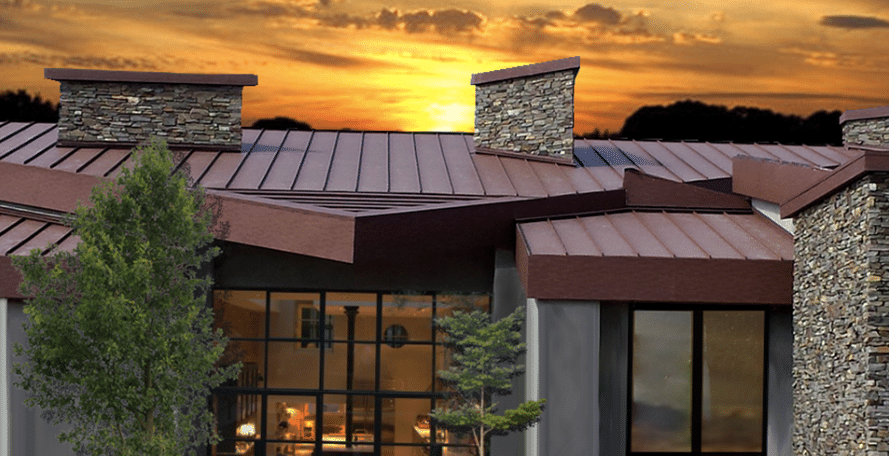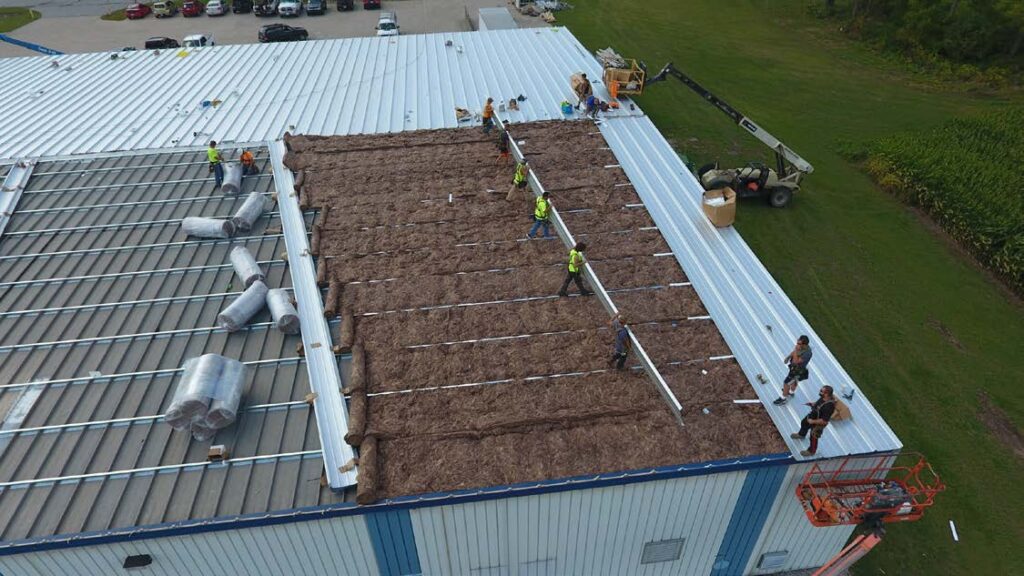The distinction between low slope and steep slope roofs is a fundamental one. For those involved in the metal construction industry, low slope roofing represents a significant area of focus due to its unique properties and applications. What exactly constitutes low slope roofing, and why is metal such a popular choice for these types of roofs? Let’s delve into the specifics. Also learn how you can get superior training by one of the industry’s leading experts, Alex Prothmann, at METALCON 2024 at the end of October in Atlanta, Georgia.

Credit: Western States Metal Roofing
What Exactly is Low Slope Roofing?
A low slope roof is a roof that has very little or no steepness. Typically, a roof that has a pitch of less than 3:12 is considered to have a low slope. While a flat roof is considered to be part of the low slope roof category, they usually only have a pitch of 1/4 inch to 1/2 inch per foot.
Low slope roofing is most common in arid, or desert like, climates where there is a general lack of precipitation as low slope roofing is more prone to water damage. In high precipitation areas, if the roofing material used is not suitable for low slope roofing and has rainwater sit on it for an extended period of time, leaks can occur because the water is unable to runoff as easily as when it’s on a standard or high slope roof.
Low slope roofing and flat roofs are commonly seen on commercial buildings due to their cost effective nature compared to standard slopes. They also allow businesses to store and maintain their A/C units on the top of the building.
According to the Metal Construction Association, building owners and architects have come to recognize and appreciate the attributes of Low Slope Metal Roofs including their long service life, low life cycle cost, sustainability, recyclability, low maintenance requirements, light weight and resistance to wind.
What Materials are Needed for Low Slope Roofing?

The materials used in low slope roofing must be able to withstand various weather conditions and provide adequate water resistance. Here are the top 5 low slope roofing options including the materials needed or typically used for each:
- Standing Seam Metal Roofing – Standing seam metal roofing is sheet metal that has a flat appearance in the center and vertical ribs at the panel edges, creating a smooth, streamlined appearance.
- Built-up roof (BUR) membranes – A BUR (built up roof) system, also referred to as a “tar and gravel” roof, is composed of alternating layers of bitumen and reinforcing fabrics, such as felt paper, and is topped with gravel to create a finished membrane.
- Modified Bitumen – Modified bitumen (mod bit) roofs consist of roofing sheets made of asphalt that have been modified with rubber or plastic. Mod bit roofs are very similar to BUR systems as they both are installed in multiple plies. However the difference is in the modified bitumen’s additions to the asphalt.
- Single-ply – A single-ply roof consists of wide sheets of plastic membrane that are rolled out over the roof’s surface and then welded together. The result is a weathertight, durable roof. The three main types of membrane used for single ply roofing are: Thermoplastic Polyolefin (TPO), Ethylene Propylene Diene Monomer (EPDM), and Polyvinyl Chloride (PVC).
- Rolled Roofing – Rolled roofing, or asphalt roll, is a mineral surfaced oil-based asphalt product that comes in large rolls. It’s available in a wide variety of colors, styles and textures.
In addition to choosing the right roofing material for a low slope, you must also make sure to use the correct roof underlayment. Underlayment is critical, and often required by building code, for low slope roofing as it provides an additional layer of protection from water which helps reduce chances of leaks and water damage.
Low Slope Roofing vs Steep Slope Roofing
Understanding the differences between low slope and steep slope roofing is crucial for selecting the right roofing system for a specific application.
- Low Slope Roofing:
- Slope: 3:12 or less.
- Common Uses: Commercial, industrial, and flat-roofed residential buildings.
- Water Drainage: Requires careful design to ensure proper drainage.
- Materials: Typically utilizes membrane roofing systems.
- Steep Slope Roofing:
- Slope: Greater than 3:12.
- Common Uses: Residential homes, particularly those with traditional pitched roofs.
- Water Drainage: Naturally drains water quickly due to the steep angle.
- Materials: Common materials include asphalt shingles, wood shakes, and metal panels.

Why Metal for Low Slope Roofing?
The use of metal in low slope roofing has become increasingly popular due to several distinct advantages. Here are some of the primary benefits of choosing metal for low slope roofs:
Durability and Longevity
Unlike traditional roofing materials, metal can withstand extreme weather conditions, including high winds, heavy snow, and hail. Metal roofs also have a significantly longer expected service life than either built-up roofing or single-ply roofs. According to 2005 study of low slope roofing conducted by Ducker International, participants said they expect metal roofs to last 40 years – 17 years longer than built-up and 20 years longer than single-ply systems. With proper installation and maintenance, a metal roof is a cost-effective long-term investment.
Energy Efficiency
Metal roofs are highly reflective, which means they can reflect a significant portion of the sun’s rays. This reflective property helps reduce the amount of heat absorbed by the building, leading to lower cooling costs during hot weather. Additionally, metal roofs can be coated with special reflective coatings to enhance their energy efficiency further.
Environmental Benefits
The energy efficiency of metal roofs contributes to a building’s overall sustainability. Many metal roofing materials also contain recycled content and are fully recyclable at the end of their life cycle, reducing the environmental impact associated with roofing materials that end up in landfills. According to the MCA, a typical low slope metal roof has at least 25% recycled content, and at the end of its long useful life is 100% recyclable.
Low Maintenance
Compared to other roofing materials, metal roofs require minimal maintenance. They are resistant to common roofing issues such as rot, mildew, and insect damage. Regular inspections and simple maintenance tasks, such as cleaning gutters and removing debris, are usually sufficient to keep a metal roof in good condition.
Versatility and Aesthetic Appeal
Metal roofing is available in a wide range of styles, colors, and finishes, allowing for versatile design options. Whether aiming for a modern, industrial look or a more traditional appearance, metal roofs can be tailored to match the architectural style of any building. This versatility makes them a popular choice for both commercial and residential applications.
Fire Resistance
Metal roofs are non-combustible and have a Class A fire rating, the highest rating available, making metal an excellent choice for areas prone to wildfires or other fire hazards by providing an added layer of protection for the building and its occupants.
Lightweight
Despite their durability, metal roofs are relatively lightweight compared to traditional roofing materials like concrete tiles or slate. Typically, low slope metal roof systems vary in weight from 40 to 135 pounds per 100 square feet, making them among the lightest roofing products and the easiest to install. A lightweight roofing system also places fewer demands on a building’s structural support system, an important consideration in earthquake-prone areas for example.
Low Slope Detailing Workshop – Certificate Course at METALCON 2025
There are “navy seals” and then there are “red seals.” Among his long list of accomplishments, Alex Prothmann, Architectural Sheet Metal Trainer, ASM 101, is also a certified Red Seal sheet metal worker. With over three decades of experience and having started his own business in 2012, Alex founded Architectural Sheet Metal 101 (ASM101) as a one-stop shop where sheet metal workers of all skill levels can gather, share ideas, and learn from each other.
Learn from the best at METALCON! Alex is bringing his expertise to METALCON 2025, offering an in-depth workshop on low slope metal roofing while also touching on steep slope roofing. Gain a comprehensive understanding of the basics of low slope metal roofing, with the goal of transforming your perspective on what is possible with sheet metal and how it applies to roofing. Understand the shifts and creative options that arise when installing metal roofing on low slope versus steep slope roofs.
This course is scheduled for Tuesday, October 21 from 1:00 pm – 5:00 pm. It is approved for 4.0 AIA LU HSW credits, and all students will receive a certificate of completion.
